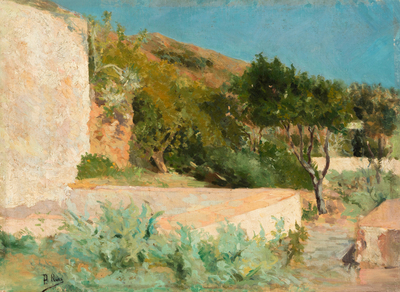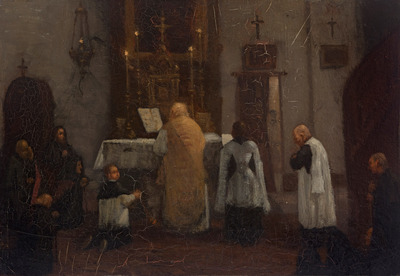This is custom heading element
Knowing the formative stage of any artist is essential to understand the foundations on which a certain character will germinate. When the artist in question is endowed with innate aptitudes and a rare spirit of observation, as is the case with Picasso, rediscovering works from that first phase of apprenticeship gives us new perspectives from which to contemplate the life of the genius.
The two paintings that Setdart brings together on this occasion confirm the aforementioned doubly, since each of them offers us a different journey into the past of the master from Malaga, each of them is an open window to the master’s adolescence: the landscape view of his native land and the interior of a church in which a Tridentine mass is celebrated were made by Picasso when he was barely sixteen years old.
By then he was already studying Fine Arts in Barcelona, but the Ruiz-Picasso family still spent some summers in Malaga and continued to visit friends in La Coruña, where they lived between 1891 and 1895.
“El Cerrado Victoria” has a certificate of authenticity issued by Josep Palau i Fabra. “La Misa”, with an extensive scientific analysis and artistic-documentary study, carried out at the Polytechnic University of Catalonia. According to these studies, both paintings can be dated to 1896. The Malaga landscape, made during a summer stay, shows a washing place in the foreground and a mountain on the right. It is a farmhouse nestled in the heart of the mountains of Malaga, belonging to the estate of the same name that Picasso frequented as it was next to the property of his godparents. Palau i Fabra compares this oil painting with several landscapes housed in the Picasso Museum in Barcelona, and published in the catalog “Picasso. Landscapes 1890-1912” (Barcelona City Council).
Despite these examples, landscape was a relatively uncultivated subject for Picasso. Compositionally, it presents a singular framing, which gives more prominence to the stone wall than to nature. But what is most remarkable is the technical skill and the boldness of the stroke, loose and free, which also beats with vehemence in “La Misa”.
Religious themes were frequent in Picasso’s production in those years, under the tutelage of Antoni Caba (see “Roman Interior Scene” at the Picasso Museum in Barcelona). But it was in the smaller formats, oil paintings on cardboard like the one we are dealing with here, where we find the religious theme treated with greater spontaneity of stroke (similar to “Baptism”, 1895, Picasso Museum). In style and technique he moves away from the influence of his academicist masters.
The scene shows a Tridentine mass (the ritual is performed with the back to the parishioners). Altar servers and friars kneel or bow their heads with reverence, directing their bodies towards the figure of the parish priest, who occupies the compositional center in front of the altar. The tabernacle glows with candles lit from the candlesticks. These confer a play of backlighting that shades the blacks and lights up the whites and golds, bathing the interior with intimate qualities. This work can be compared to “The First Communion” (1896), in which the figures also withdraw into their interior before the sacredness of the event. The Picasso’s genius, the rebellious breath, emerges in every brushstroke of this composition with a traditional theme.
The two works that Setdart is offering for sale on these dates bear witness to a singular moment in the heart of Picasso’s early period, because under an appearance still attached to tradition, the temperament of an unrepeatable figure is already struggling to express itself.
Both paintings were initially given by the family to close friends in Malaga and La Coruña, respectively. After that, each of them went through a unique journey, from heir to heir, until they were fortunate enough to come out of their safes and offer again the opportunity to be acquired. A unique opportunity for the most demanding collectors.







